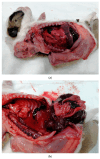"My Bitch Is Empty!" An Overview of the Reasons for Pregnancy Loss in Dogs
- PMID: 40005887
- PMCID: PMC11860774
- DOI: 10.3390/vetsci12020127
"My Bitch Is Empty!" An Overview of the Reasons for Pregnancy Loss in Dogs
Abstract
The purpose of this review is to present reasons for pregnancy loss in dogs. Termination of pregnancy can occur at any stage of gestation, sometimes even before pregnancy is diagnosed. If embryonic death occurs before day 35 of gestation, the embryo is absorbed. Fetal death in the second half of gestation leads to abortion or fetal emphysema, maceration, or mummification. Abnormal embryonic development, competition between placental sites, or genetic abnormalities of the embryo(s) can lead to termination of pregnancy. Maternal factors that alter ovarian function or the environment in the oviducts and uterus, such as cystic endometrial hyperplasia or inflammation, can lead to pregnancy loss. Abnormalities of the placenta, uterine torsion, metrocoele, environmental stress, and malnutrition can have detrimental effects on fetal development. Several drugs or medications can also have embryotoxic/teratogenic effect. Endocrinological disorders such as hypoluteodism, gestational diabetes, and hypothyroidism can be reasons for pregnancy failure. Several bacteria, protozoa, and viruses can cause pregnancy loss in dogs. Etiological diagnoses of pregnancy loss in dogs are challenging as the exact causes are not always obvious; so, a multi-faceted approach is required.
Keywords: abortion; canine pregnancy; endometritis; infertility; resorption.
Conflict of interest statement
The authors declare no conflicts of interest.
Figures






Similar articles
-
Causes of pregnancy arrest in the canine species.Reprod Domest Anim. 2023 Sep;58 Suppl 2:72-83. doi: 10.1111/rda.14407. Epub 2023 Jul 20. Reprod Domest Anim. 2023. PMID: 37312645 Review.
-
The uterine artery resistivity index is affected by embryo resorption rate at canine pregnancy diagnosis.Theriogenology. 2025 Mar 1;234:19-23. doi: 10.1016/j.theriogenology.2024.11.024. Epub 2024 Nov 28. Theriogenology. 2025. PMID: 39631252
-
Fetal loss in the dog and cat.Vet Clin North Am Small Anim Pract. 1987 May;17(3):535-54. doi: 10.1016/s0195-5616(87)50052-3. Vet Clin North Am Small Anim Pract. 1987. PMID: 3299998 Review.
-
Embryo development, hormonal requirements and maternal responses during canine pregnancy.J Reprod Fertil Suppl. 2001;57:169-79. J Reprod Fertil Suppl. 2001. PMID: 11787146 Review.
-
Imbalance of mononuclear cell infiltrates in the placental tissue from foetuses after spontaneous abortion versus therapeutic termination from 8th to 12th weeks of gestational age.Clin Exp Med. 2006 Dec;6(4):171-6. doi: 10.1007/s10238-006-0111-x. Clin Exp Med. 2006. PMID: 17191109
Cited by
-
"My Bitch Is Empty!" an Overview of the Preconceptional Causes of Infertility in Dogs.Vet Sci. 2025 Jul 12;12(7):663. doi: 10.3390/vetsci12070663. Vet Sci. 2025. PMID: 40711323 Free PMC article. Review.
References
-
- England G.C.W., Allen W.E. Studies on canine pregnancy using B-mode ultrasound: Diagnosis of early pregnancy and the number of conceptuses. J. Small Anim. Pract. 1990;31:321–323. doi: 10.1111/j.1748-5827.1990.tb00819.x. - DOI
Publication types
LinkOut - more resources
Full Text Sources

